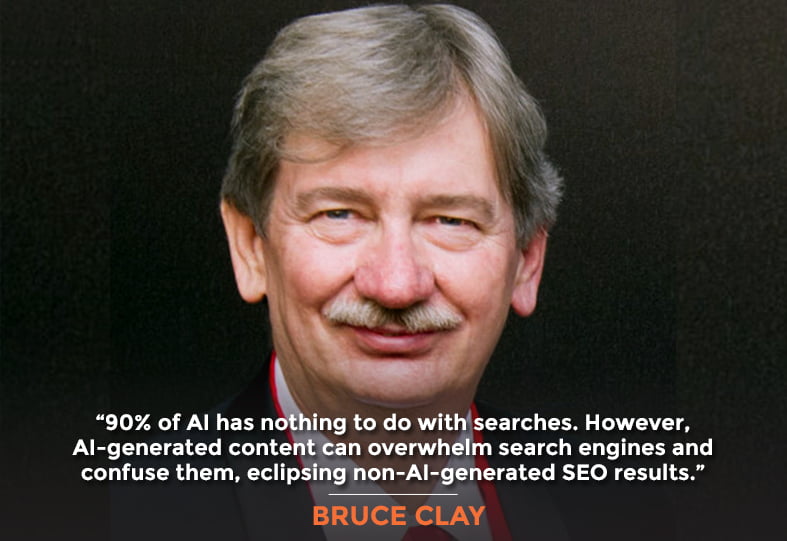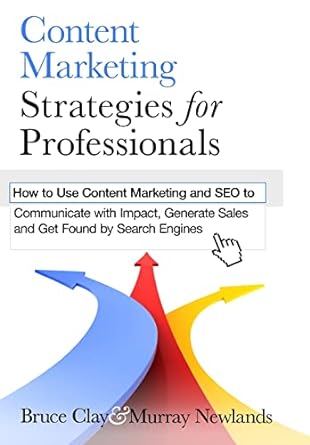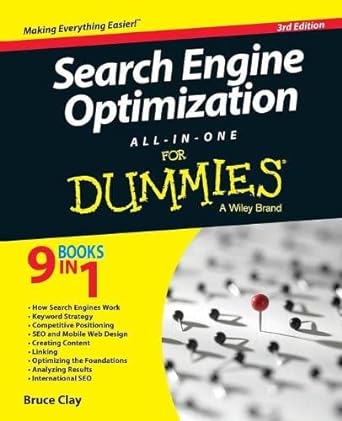The internet is evolving at an ever-advancing rate. With AI now able to generate content, how can businesses ensure their websites rank high in search results? Especially since their competition can now flood the market with massive amounts of inexpensively created content! In this episode, we delve into the future of search engine optimization with an industry pioneer.
Bruce Clay and I go way, way back! We’ve spoken on numerous panels together over decades, so it’s really a pleasure to have him here on the show. President of Bruce Clay, Inc., he’s authored several acclaimed books including Search Engine Optimization All-in-One for Dummies now in its fourth edition. Bruce created the first webpage analysis tool, the Search Engine Relationship Chart, and coined the term “search engine optimization.”
With over 27 years in the business, Bruce shares his unique perspective on leveraging AI tools while avoiding pitfalls like low-quality content. He reveals ninja blogging tips and also gives an inside look at building his global digital marketing company and the key lessons learned from gatherings like SEO Oktoberfest.
Whether you’re an SEO expert, digital marketer, or business owner, you won’t want to miss Bruce’s unconventional wisdom. Tune in to learn why he believes search is shifting from keywords to questions, and how you can prepare your website for the AI-driven future. And now on with the show!

In This Episode
- [02:35] Bruce Clay shares insights on leveraging AI tools in SEO while avoiding low-quality content.
- [08:41] Bruce highlights the capabilities of chat tools in generating outlines and articles but notes that they are not yet advanced enough to optimize content for Google rankings.
- [11:43] Bruce discusses experimenting with adding an FAQ section to blog posts to see if it affects featured snippet visibility.
- [23:37] Bruce talks about his company’s expansion into new markets, including Tokyo and Milan, and the reasons behind these choices.
- [28:44] Stephan asks Bruce about his SEO training, courses, and consulting services.
- [37:12] Bruce predicts the future of content creation with AI and SEO.
- [39:23] Stephan briefly explains the concept of dead internet theory.
Bruce, it’s so great to have you on the show.
Thank you. I’m glad to be here.
We’ve known each other for many years. We’ve been on countless panels and seen each other at many conferences. Just to start things, you’ve got a lot of wisdom. What unconventional wisdom would you have garnered and acquired through all these years of being in the search engine industry, attending conferences, and flying on so many airplanes? What would be something that’ll just blow our listeners away?
Well, I’m not sure because I’m speculating that your listeners are, likewise, typically industry-mature people. We have topics ranging from some of the newer ones, like AI and where that fits—I have opinions about that—to work structures and any number of topics. I don’t know if anything would blow people away other than in the area of AI. I’ll talk there. I don’t think people understand what AI is.
AI is a great research tool. It provides a foundation to help writers create quality documents faster — it's not designed to fully replace human creativity. Share on XFirst of all, AI is a tool—that’s all it could be—and it’s running circa 2021. It can’t do a vast majority of the things that many people want it to do, but it can do plenty. For instance, I can say, “Write an email to Stephan in the voice of a pirate,” and it would rephrase my email and make it a pirate. I can do fun things.
It turns out that probably 90% of everything in AI has absolutely nothing to do with search. Search probably doesn’t even care about AI. It’s just that people are going to be using AI to generate content, and that content is going to find its way into search, and search engines are rightly confused about it.
The worst thing about it is that some people will take a keyword and stick it into an AI—ChatGPT as an example—say, “Generate a page,” it’ll generate a page, and they’ll just take it and submit it to the website. Or spin it to somebody else’s website because they don’t care about that somebody else. And there’s going to be a ton of garbage created.
We must understand that AI, chat, and everything else as a tool are great at maybe doing some keyword research. It’s great at maybe even doing other research. “What have you seen?” Because not everything has to be within the last year. Get an outline, give it to a writer, and let a real artist create the document. It could save time, but it is not designed as the solution.
I think if you use it as the solution, you’re going to have two problems. One, it’s going to be garbage. The statistics on the market that I’ve seen in articles is that when people do surveys, they typically find that most AI articles are not liked as much as artist-writer articles. So, writer performance is better than AI.
The second thing is if AI reads AI to build its opinion, all AI will ever do is understand what’s regurgitated content from five years ago. It’s not possible to be creative. It’s not able to invent. It’s not necessarily able to imply things.
If AI can’t answer it, it fills in the blanks with something, and then it’s still our job to figure out whether it’s a lie.
Yesterday, while playing with AI, I had a list of keywords. I said, remove all the keywords that are one word. It didn’t. Then I said, “Remove all the keywords that are less than two words.” It didn’t. I asked, “How many words are in each element in this keyword list?” And it had it right.
Then I had to ask, “How do I get you to remove the one-word phrases?” I used that, and it worked. But 90% of the people aren’t doing that. They’re just, “Here’s a keyword, give me an article,” and you’re getting all sorts of really bizarre things out of the articles.
Hallucinations are what they’re called.
Hallucinations. Here’s a cool one. I said, “Write an article. I want you to quote books and give citations.” It did it three times in the course of the article, which is great. But the ISBN was always 0123456789. When I looked up, the author was a fictitious person. What seems to happen is if it can’t answer it, it fills in the blanks with something, and then it’s still our job to figure out whether it’s a lie.
This reminds me of, who was that character on Saturday Night Live? He was a terrible liar. He’s like, “Yeah, that’s it.” You remember that guy?
Yeah, and “What do you have? Have you ever seen it?” You call chat on it, like you’re talking to someone. It apologizes. “I’m sorry, I didn’t understand the question.” Or, “Oh, I got that wrong,” then it gives you a different answer. I liked it when the guy said, “What is two plus two?” And chat came back and said, “Four.” Then he said, “My wife says it’s five.” Then chat came back and said, “Then it must be five. Your wife is always right.”
That sounds like a skit from Saturday Night Live or something. By the way, it was Jon Lovitz on Saturday Night Live. His character was Tommy Flanagan.
Well, with chat, it’s doing a fair job on most things—not everything, but most things. If you do it correctly, it can give you a good solid outline. You can even have it write an article on many evergreen topics, where it isn’t state of the art changing every second, and it’ll give you a reasonable article.
I’ve been running experiments. If you took one of those articles and gave it to a writer, the writer can fix it in an hour and a half. They could have written it in the first place in three hours, but in an hour-and-a-half, they can fix it. How much time is that saving, considering the investment in the time to actually get the outlines or the draft article to start with?
This is our PreWriter.ai product—we talked about it a little bit earlier—and what it does is take your input and generate information for writers. It just sets them up, and that’s all it does.
AI content in search results confuses search engines.
I can say silly things like, “Given this keyword, reverse engineer the top ten Google results, combine them into one keyword list and construct a page and sub-pages that emphasize those.” It’ll build all the outlines, build the pages, and it’ll all be done.
We know chat can’t do it because it doesn’t go to Google or care about the web, so we’ve had to build strong programming around it. But you can do it. There are fifteen functions and everything. It’s great at keyword research.
I can point it at any website and say, “Reverse engineer it,” and it will. It can do that, provided it doesn’t have to invent anything. It’s where you get into where it is going next, and what does that mean? You’re not going to get past that.
Anyhow, the generation of chat is that it’s amazing. It does an awful lot of things right. I can tell it to write a sales letter using a particular technique like PAS (pain, activate, and solution), and it’ll write a sales letter in that form. It’s great, but sales letters won’t be optimized in ranking in Google anytime soon.
As long as you don’t have to worry about it—you can read it, the sales guy can say, “Yeah, I’ll put my signature on it, and it can go out, and you can do things like that—I think that AI is very useful today. It’s just a long way from being a website.
Has AI written any of your blog posts on bruceclay.com?
The generation of chat nowadays is amazing.
No. We are experimenting. As you know, I have always inflicted pain on myself because my website ranks pretty well, so I can see what’s happening. If you go to my blog page and open up any blog there, we’ve added a small section called an FAQ to the bottom of the blog post just to see what happens. I know it sounds strange, but I did it.
If you go to the FAQ and highlight the question that the FAQ answers, just highlight that question and do a Google search. In almost every case, not every case, but in almost every case, we’re the featured snippet. You don’t search in quotes; you just search.
I don’t even quite know what to make of it myself. It’s just that that’s an experiment we’re running to see what would happen. But the question itself shows us the featured snippet, and it highlights the portions that are within that area just fine.
I just tried that on your second to the last blog post on content—Five Steps to Help Writers Create Expert Content for SEO.
The FAQ question at the end was, “How can I ensure quality content as part of an SEO program?” I copied and pasted that and didn’t put quotes around it. I pasted that entire phrase in. The featured snippet was HubSpot’s blog. Then, the people also asked, “How do I create quality content for SEO?” I expanded that, hoping it was there. Nope, that was a yoast.com post.

I find that sometimes—as I said, not every time—if you use the wrong words, for instance, one of them discussed COVID, well, in the COVID world, you get NIH results and all sorts of stuff. You’re not going to necessarily show up. But out of the ten links, we’ll probably have seven with a featured snippet.
Do you see much benefit in getting a featured snippet? Studies show that featured snippets don’t get as many clicks, and perhaps the conversion isn’t as high as just being in the regular organic position.
I understand that. The formatting changes that Google has made recently help. Let me tell you what is important. We’re going to a chat world. Now, you and I both know we’ve been around forever. I think collectively, we’re about 250 internet years on SEO.
Questions will drive the future.
When you look at the beginning, it is a page. Search engines were primitive enough that everything was keyword-based. Keywords drove the first 12 years of the search.
What I think is going to happen is that questions will drive the future, maybe in six months or a year. Questions will be the way people query. And chat has been the catalyst for that. But I think that people are going to query with questions.
One of the things I’m doing with our technology is we’re generating these FAQs. If we generate the FAQs correctly, and they’re smart enough, ultimately—instead of keyword-based searches, they’re going to be question-based—whoever has the most questions wins.
If I took an entire website about SEO, and I were to go through and add an FAQ to every page that is appropriate to the content of that page, I think that, ultimately, I’m going to win. In the case of all your listeners, they are in all these different categories.
But if people ask questions instead of typing in keywords, whoever has the most questions ultimately wins. That’s what I am developing the product for. It’s pretty smart. At least in a fair number of times, it’s smart enough to get the featured snippet.
Questions, not keywords, will drive searches in the near future, and chat is the catalyst for this shift. Share on XIt’s a very clever idea. I have to commend you on that. I have not seen bloggers put FAQs at the bottom of their blog posts. That’s quite innovative. I’ve seen plenty of sales pages, landing pages, and even product pages with FAQs at the bottom of the page, but yeah, that’s quite innovative. Where’d you come up with that idea?
I figured that was where the search was going, and I better put it everywhere. I have an inventory of very old blog posts that I’m cleaning up. I have 4000 of them. Let’s put it that way. It’s old. All the live blogging from the conferences and years. I’ve been around 27 years. I got a lot of blog posts.
We’re finding that about 80% of them have been replaced without a redirect, or are just obsolete, or it’s not as strong as some more recent ones, so we’re going through. 80% are going to redirect, the 20% that are left we’re rewriting, and all of them—that’s going to be about 800–1000 blog posts—will all have FAQs appropriate to the content. It’s all going to be recent.
Answering questions on your website will improve your search engine ranking as interfaces shift from keywords to questions.
I have a full team of people just rewriting all my stuff. That’s a lot of writing, but we’re redoing it all. We’re going to find that the fact that questions are being answered on your website en masse will help you rank when the transition goes from keyword to question as a search interface.
We all know that Google and Bing are working on it. Everybody else, I’m sure, is working on it. Given that they will go in that direction, we want to get there first. That’s my product.
And this product is called PreWriter.
Awesome. What are you doing to market that? You want people who aren’t just Bruce Clay, Inc. clients, right?
Right. We’re building our site and will make it available to everybody.
So you’re still in the product development and beta testing phase, right?
We’ve been running it internally for a while, and we’re probably ready to let somebody try it in a couple of weeks for a release by the end of September-ish. When everybody hears this, you’ll be able to go to PreWriter.ai.
What it’ll do is you’ll put in, let’s say, “This is my keyword,” and it’s going to give you a pre-written page, an FAQ, and a complete profile of the page. It will say, “This is the primary keyword, this is your title, here are four questions appropriate, these are your meta tags, and this is your abstract.” It’s just a whole slew of information about the page. From that, you give it to a writer, and the writer, with that information, has all they need to finish the article.
I’ll tell you right now: too many people are finding that they can’t give up writing because it requires that you be a subject matter expert, and it’s hard to find writers who are subject matter experts for you. So you’re going to have to finish your writing. But why do you have to spend the two hours at the front doing what we can give you in fifteen minutes? Push a button. There you are. You have to give it a keyword, but it’ll give you back what you want.

The economics of it are astronomical. But the thing is, you can’t just do that with chat. You can’t go to chat and say, “What’s the top ten ranking in Google?” There’s either an automation process or a lot of human intervention. While all of the possible stuff can be done by human intervention, automating it is the right way. So it’s interesting.
As you may recall, we have a patent, and it’s a lockdown-strong patent. The patent says, “For a keyword, you go to Google or a search engine, you do the query, you take the top results, you spider them, you extract out characteristics common to each of them, and you set that as a target that you would use for creating content.” That’s our patent.
We’re in a lot of litigation right now. Not a lot, but people are violating the patent. They’re doing exactly that. But why would anybody want to do that if I’m selling it to you for a dollar? You can’t even imagine not doing it right. It’s a long story about what we’re doing, but it’s pretty complex. I’m pretty excited about it because I can take a keyword and generate a page, an FAQ, and a profile in four minutes.
That’s cool.
I only have two patents. One is an artistic rendering patent, and one is the actual technology of gathering, spidering, and calculating a behavior as a result of analyzing the top ten pages.
No writer could do that.
Have you talked with Christoph Cemper and what he’s doing with AIPRM?
No. I haven’t talked to anybody about it. There are many people doing things that look to infringe, but there are many people going in different directions as well, from what I can gather.
I would talk to him. Maybe there’s some synergy there. I forget how many millions of people are on his platform using his Chrome extension, the AIPRM. It’s like a marketplace for prompts. It’s really cool. I just interviewed him recently on this podcast. There could be some synergy there. I would connect with him.
You mentioned your patent. How many other patents do you have?
I only have two patents. One is an artistic rendering patent, and one is the actual technology of gathering, spidering, and calculating a behavior as a result of analyzing the top ten pages. I’ve had that for a number of years.
Have you gotten companies to come to you asking to license that patent?
Yes.
Are you currently licensing it? Do you have companies that are using it now?
I only have one, mostly because he behaved correctly. But others, there may be settlements that’ll do it. I’m not worried so much about it. But I also don’t like insults, so it’s up in the air.
Interesting. How big is your company now? We haven’t spoken for a little while. Regale me with all the successes, like how many offices, your team size, and everything else.

Here in the US, we’ve been using contractors through agencies. We’re still coming out of the COVID period, so we’re probably around 40 US. We got 60 in Tokyo. That’s our largest international office. But we also have offices in Sydney, Singapore, Milan, and the second largest is just outside New Delhi in India. Each of the offices services their regions.
Overall, we got a couple of hundred people, but here in the US, it’s 40. I did have an office in Dubai for UAE. That office was just recently purchased.
Congratulations.
Yeah, that worked out well.
Awesome.
But I can’t go back to the UAE for about another two years. We’ll see what happens. I don’t know that the UAE is a particular target as much as Europe seems to be. The Milan office is growing. It’s bruceclay.eu and it’s growing pretty good.
Why Milan and not Paris?
For some reason, where we’re at, Milan is just a stone’s throw from Switzerland. There’s an economic advantage to that. It’s like everybody there speaks English. I just found it easy to do in Milan, but they’re opening everything down from the UK. I think they have people in every country. Where you’re at in a virtual world is much less important now.
How did you settle in Tokyo to set up a branch office?
Tokyo was the hub of most of the businesses in Japan. It’s a very large business hub. You know how you’ve seen in movies where the people are crossing—I forgot what they call it in Japan—how they have these big striped intersections? We are a hundred yards from that. We are in the building next to Google, so it seemed the right place to be. Now, Japan is in an interesting situation in that—
Search results are shifting from keywords to questions. The smartest and most relevant FAQs will rank the highest in results. Share on XWere you talking about Shibuya Crossing?
Yes. I’ve been there four or five times. You don’t go in the summer, it’s humid, but it’s very nice. The difference in Japan is they’re a multi-bit language. They generate more than half of their revenue from pay-per-click because it’s far easier to do pay-per-click in Japan.
The offices will vary based on their regions, but it’s a pretty good network. We support each other, make it work, keep going, everything’s fine. I’m happy with it.
Another part of the story is Tokyo, Sydney, Milan, and Dubai. I’ve been to the Taj Mahal twice in India. When you look at them, I commonly would end up with an office where I wanted to vacation. You fly in, see the coliseum, take the train up, see David’s statue; take the train up, see the glassworks in Venice, and then take the train over. Once you’re in Italy, it’s a very nice country. I think I like it.
Where you’re at in a virtual world is much less important now.
How often would you visit these offices to check on the team and what’s happening?
They’d sometimes schedule a meeting with clients or even a training session, and I would go once a year.
One time, I decided I was only going to fly west. I had to go to India, and India was on the exact opposite side of the planet. I flew around the world because I only flew west. I only did it once because the number of hours you sit in an airport is terrible. But I said I wanted to do it, so I did it. I’ve flown around the world. A lot of it is great when you go.
Did you take your wife with you when you went around the world?
No, that was before we were married.
See that wouldn’t appeal to me to do it on my own.
Well, I was on my way to visit the office in India. I can fly east through Germany because you stop, switch, and go over. Or I could go west. Technically, the time in the air was only one hour difference. It’s the sitting in the airport waiting for your flight that’s the killer. But I’m glad I did it. It’s one of those bucket list things.
Awesome. You mentioned doing training sessions or workshops. How often are you doing those these days? What makes your training better than what they find elsewhere?
For years, I would have a 4½-day classroom course. People would fly in on Monday, and they leave at noon on Friday. It was 4½ days of pure SEO. It was pretty concentrated.

Then comes COVID, and I couldn’t do much with it because I can’t have a classroom course. I happen to own some nice domains. I own seotools.com. I also own seotraining.com. So, I decided I was going to record my training.
One of the interesting things is when you take a 4½-day course and record it, and you cut out a lot of stuff. There’s no interactive Q&A. I would do an hour a day of Q&A just for the audience. You don’t have breaks, and you don’t have the things that fill in a 4½-day week.
I created seotraining.com, put up a 15-hour video course with 46 slices, and made it a membership. People can go to seotraining.com, it’s $149 a month, month-to-month, sign up, take the training course, take it again next month, and take it again the month after that. I have monthly Q&As. We have Ask Us Anythings, ebooks, white papers, and an education environment on seotraining.com, and that’s replaced pretty much my classroom course.
People are feeding keywords into AI to auto-generate pages of low-quality content. Then they submit this content to websites as their own. Share on XAs it turns out, I have refreshed my content for the classroom course, and I’m wondering whether I should do it again and make it a Tuesday, Wednesday, or Thursday course. I kind of like giving the course. I mean, I enjoyed it. And people would come. I’d have 30 people in the class paying $3000 each. I’m okay with that every other month. But COVID, of course, threw a wrench in that work. But yeah, now we’re doing it online, and I think maybe once a year, I’ll do a classroom course.
Cool. I’ve been familiar with your training in collaboration with Pubcon and other conference organizations. Have you picked that backup, or is that now in the past post-COVID?
No. I’ll use SMX as an example. With SMX, I’m one of their masterclass instructors. I teach there probably three times a year. They set me up to give a one-day version of my course, not the whole week. It’s two half-day sessions.
We’ve got one coming up, actually soon. They do one every four months, and it works out well. I don’t know the schedule for next year, so I can’t get into that. SMX is still a virtual conference. I’m sponsoring brightonSEO in San Diego in the US.
I just interviewed Kelvin Newman. We were talking about that event.
I’m a sponsor, and I’ll be there. I’m not teaching there. I’m just going to see how well it’s going to do. This is their inaugural conference in the US. Looking around, I think the average person doesn’t care to wear a mask anymore. The only time I’ve had to wear a mask in the last couple of months is when I see my doctor because doctors’ offices still have mandatory masks.
I guess maybe in California. That’s not the case here in Florida.
Well, they didn’t want masks in the first place in Florida, so that makes sense. But here in California, if you go to a doctor’s office, everybody’s in a mask. But let’s face it. You’re going somewhere where everybody’s sick, so you might as well wear a mask. It’s not a big deal. Everybody got used to it. And now, with all the smoke problems in the Northeast, they’re back to wearing masks in New York City sometimes, so hard to say.
There’s a lot in SEO because of the complexity built up over the years.
We live in interesting times.
Yes.
What if somebody wanted to hire you individually, say, “I only want to work with Bruce Clay.” Do you offer an hourly rate?
I used to, and it was $1000 an hour, figuring that nobody would ever hire me. Then people said, “Okay,” and they started hiring me. Then, I stopped doing that because I didn’t expect to be hired.
Quite frankly, there’s a lot in SEO—I think it and everybody else knows it—because of the complexity built up over the years, where there are things that are easy to do. They’re repetitious. They’re title tags. Anybody can do schemas. You go through those levels.
But then you have a level where something’s wrong, and nobody knows what it is. That’s where I prefer to play. But that’s not a full-time gig. I typically don’t do one-off consulting.
Having said that, some people periodically want me involved, and I’m already involved with all my clients. I’ll just randomly sit in. I’ll review all my clients every week with the staff. So, I’m heavily involved. I’m just not the person on the phone all the time. But I don’t think I want to be selling my time anymore.
A lot of the educational advantage of those conferences was that I dealt with the people, and there was mutual admiration and support.
No, it’s not a good use of your time. You have higher value uses of your time, for sure. Now, one of the things I remember you would do is research and development, learning and growing. You’d go to SEOktoberfest all the time every year. Like how often did you go to SEOktoberfest?
That’s twice.
Oh, you went twice. What were some of the experiences, lessons, or nuances that you got out of it that made it so valuable?
Logically, it was 50 of the top SEOs in the world. I heard from people doing SEO in areas that had nothing to do with me. About a fourth of the people in the room are black hat. You got to hear things that I would not ever hear at a conference, that I would not read, typically. They would say, “But if you do this, this is what happens.”
A lot of the educational advantage of those conferences was that I dealt with the people, and there was mutual admiration and support. It wasn’t adversarial, but it was things I had not had to think about or would think about normally. Those are things that you have to hear. It was only a week a year but a good session. It makes you aware that things like that happen.
Where do you think things are heading in terms of black hat SEO and black hat AI? You were talking earlier about a ton of garbage being created by AI users to overwhelm search engines with content. I think that’s just scratching the surface of what this could become.
I think you alluded to it somewhat that I think of this visual of a snake eating its tail, where there’s much more content created by AI than by humans, to the point where AI is just regurgitating its own content. It doesn’t differentiate, so it’s a race to the bottom.
What we’re dealing with isn’t intelligence. It’s a regurgitation of somebody else’s knowledge.
Right. The concept of AI is that it learns from an LLM (large language model), and if it populates it with its stuff, pretty soon, you’re only going to hear your stuff because it is the majority of the model. I think that’s a problem.
About two weeks ago, I was reading an article about black chat usage. People are using chat to do all sorts of things. You absolutely can use chat to tell how to do something illegal, and it’ll tell you. While Google claims it will try not to do that, chat doesn’t know, and it’ll tell you all sorts of things.
They’re already starting, in some cases, a backlash against it, giving away things that are harmful to society or blatantly illegal items. You can’t do that. Chat doesn’t know the difference. It’s just content. “Next word. Next word. Next word. Thank you, there it is.” It doesn’t know what it wrote. It doesn’t think about what it wrote. It doesn’t understand what it wrote. I just wrote it.
There’s a concept of artificial intelligence in my mind. When I think of artificial, let’s take artificial sweeteners. They’re fake sweeteners. Some people want it to taste this way, but it’s not that substance. When I think of artificial, I think of fake.
What we’re dealing with isn’t intelligence. It’s a regurgitation of somebody else’s knowledge. You’re just a creative wordsmith who puts their knowledge in a specific sequence that reads correctly, and you’re getting credit for succeeding. I think that artificial intelligence is fake. It’s certainly not intelligence.
By the way, have you heard of the dead internet theory?
No.
Oh, you have to Google this or look it up on YouTube. There are some fascinating videos like the one from The Why Files.
It reckons that most of the Internet is fake. It’s bot activity, auto-generated content, quitting communities and so forth, a lot of the media manipulation that’s happening, and it’s just manipulation of the population because social media, forums, all these communities and so forth are swaying in one direction or another.
Just like you can fake Amazon reviews, you can fake articles, you can fake comments, you can fake posts on social media. This has been around for a while, this dead internet theory that it’s, “Hey, we’re onto you. We know that most of this is fake and that you’re just trying to program and manipulate us.” That’s a fascinating rabbit hole to dig into if you’re interested.

I also know that we’re out of time. You have a hard stop, don’t you?
Yes, I do.
Okay. We’ll leave it on dead internet theory. How does our listener or viewer get in touch with you and your company to hire you for SEO services and all that good stuff?
And I wish everybody would. They would find us through bruceclay.com. Right at the top, it says, “Contact us.” That’s the easiest way to do it. Right now, we’re 100% in the US, and we’re 100% remote, but we typically get back to folks promptly. So reach us through bruceclay.com.
Awesome. Well, thank you, Bruce, and thank you, listeners. We’ll catch up with you in the next episode. I’m your host, Stephan Spencer, signing off.
Important Links
Connect with Bruce Clay
Apps and Tools
Books
Businesses/Organizations
Film
People
Previous Marketing Speak Episodes
YouTube Videos
Your Checklist of Actions to Take











About Bruce Clay
 Bruce Clay is the founder and president of Bruce Clay, Inc. He authored the books—Search Engine Optimization All-In-One For Dummies, now in its fourth edition, and Content Marketing Strategies for Professionals. He wrote the first webpage-analysis tool, created the Search Engine Relationship Chart® and is credited with being the first to use the term search engine optimization.
Bruce Clay is the founder and president of Bruce Clay, Inc. He authored the books—Search Engine Optimization All-In-One For Dummies, now in its fourth edition, and Content Marketing Strategies for Professionals. He wrote the first webpage-analysis tool, created the Search Engine Relationship Chart® and is credited with being the first to use the term search engine optimization.







Leave a Reply